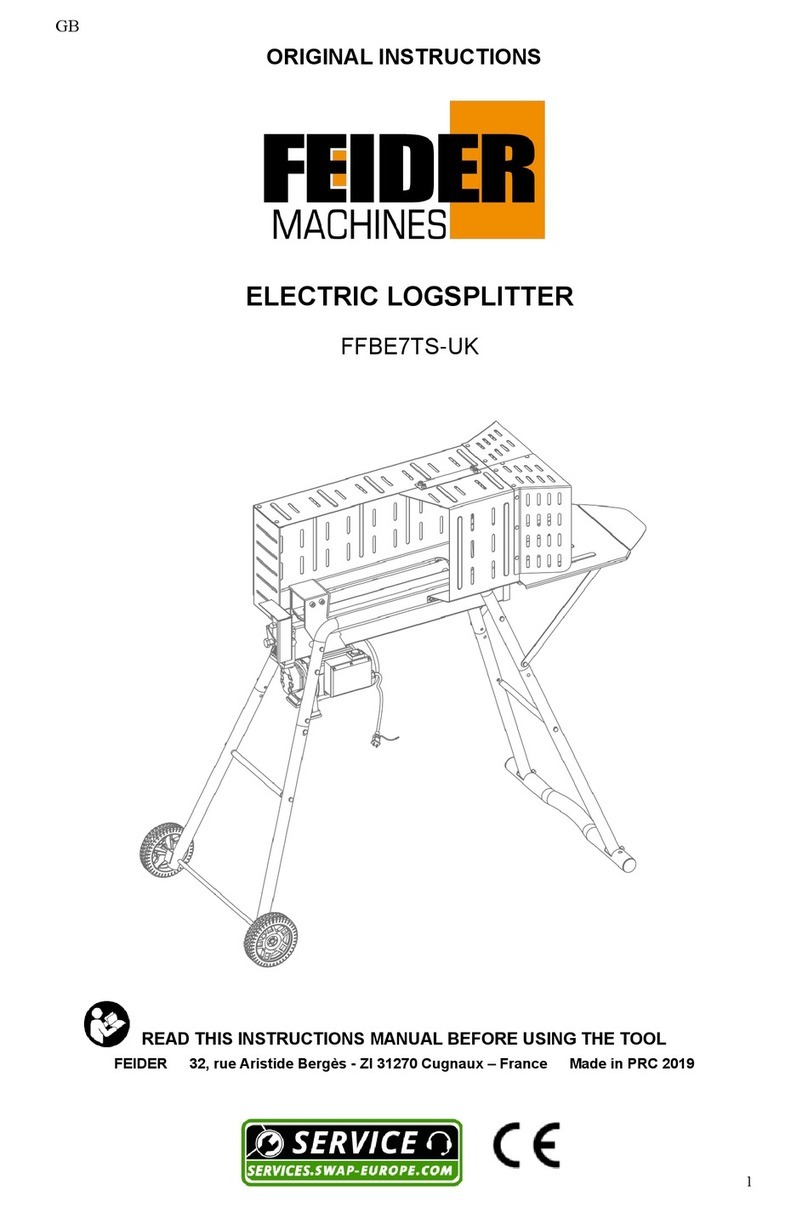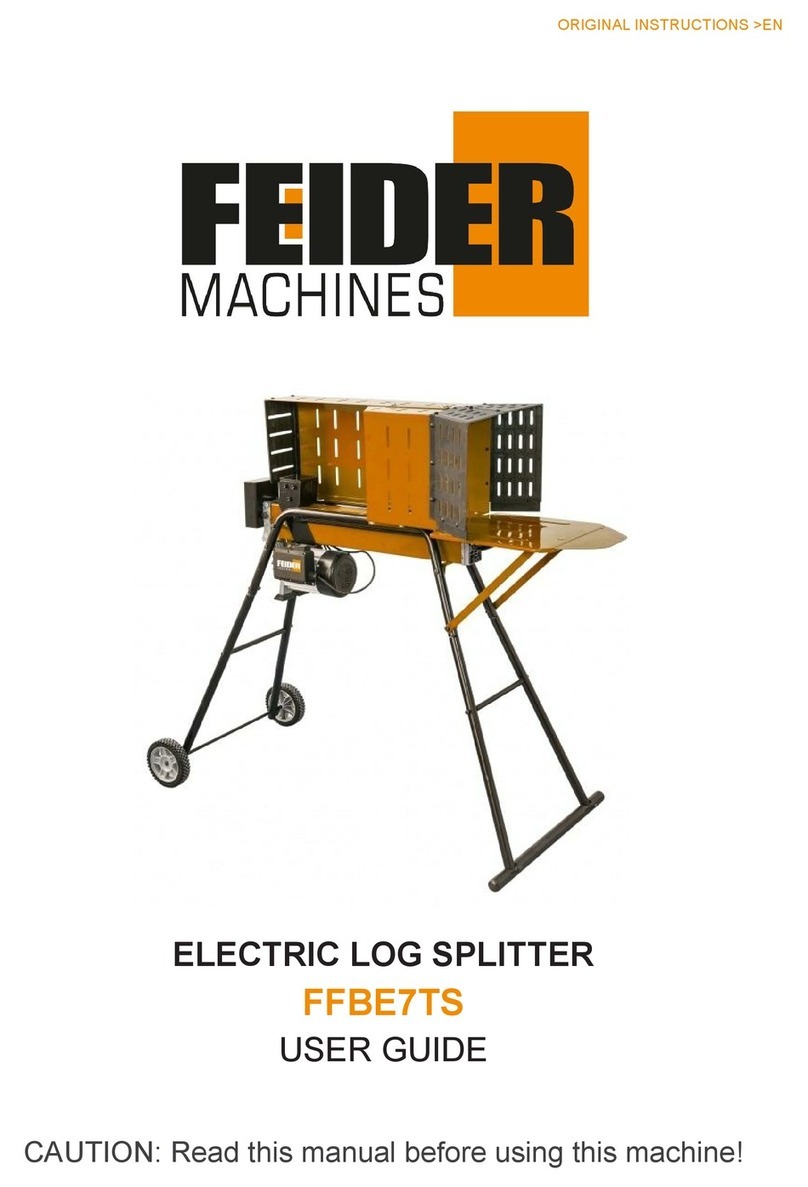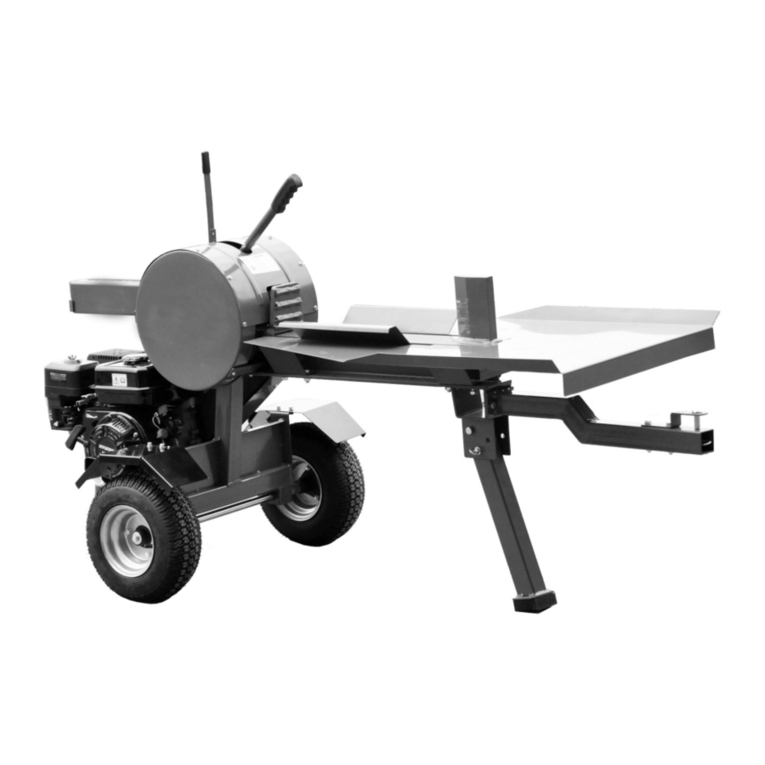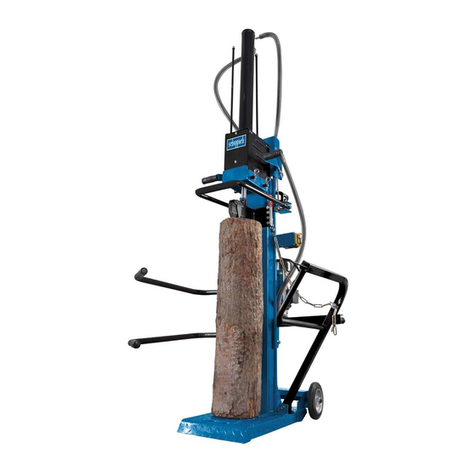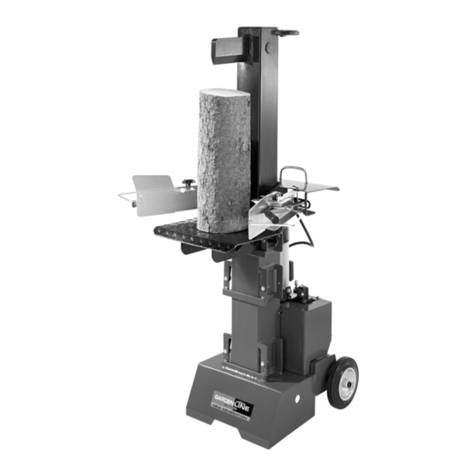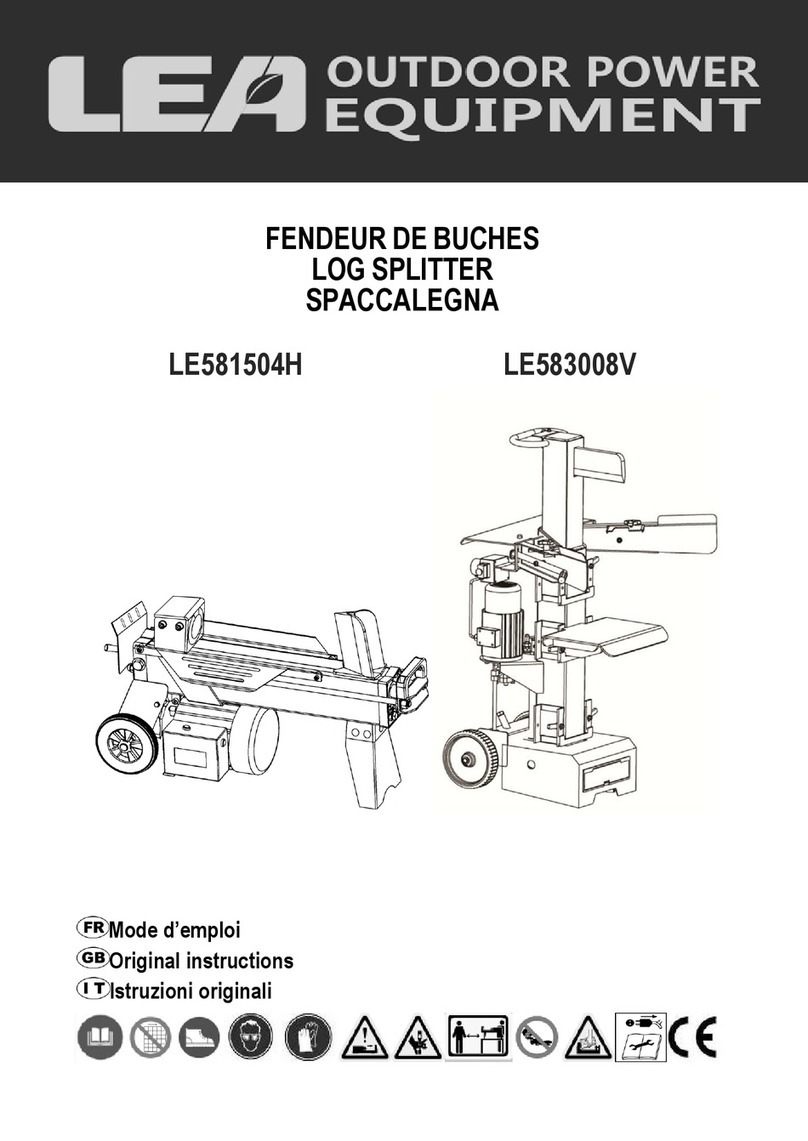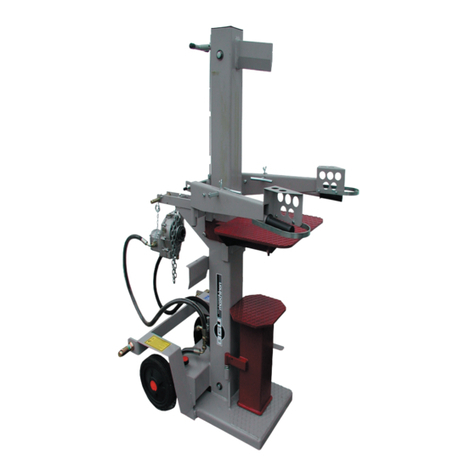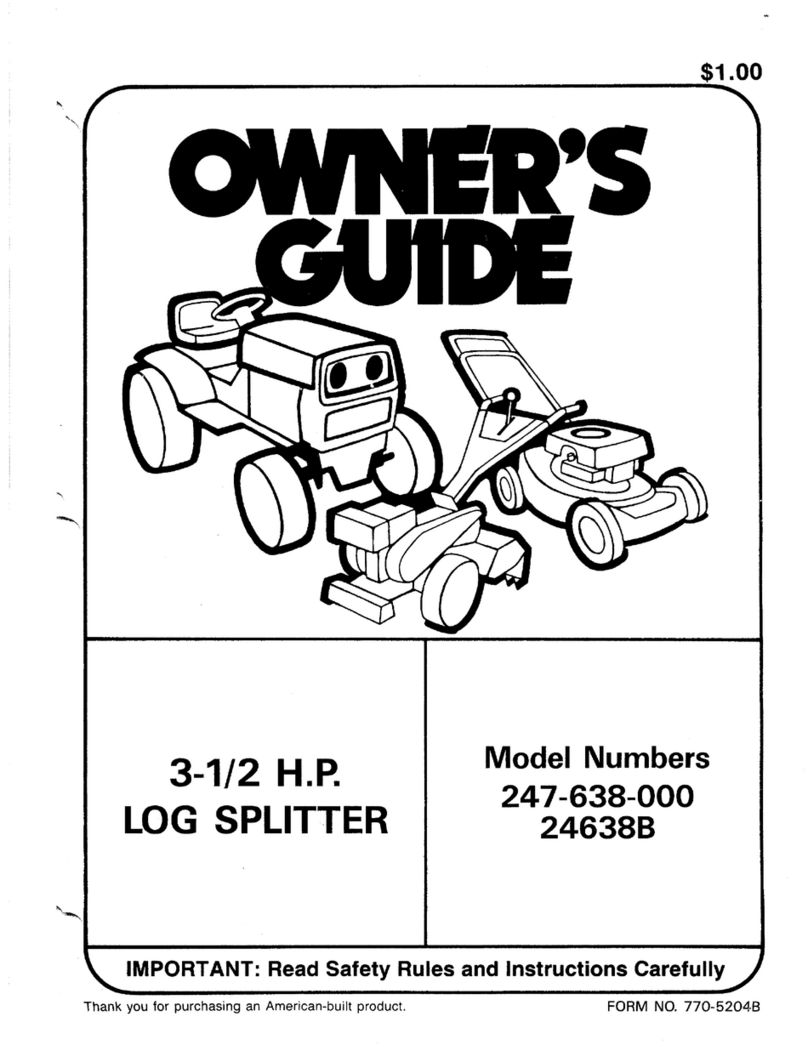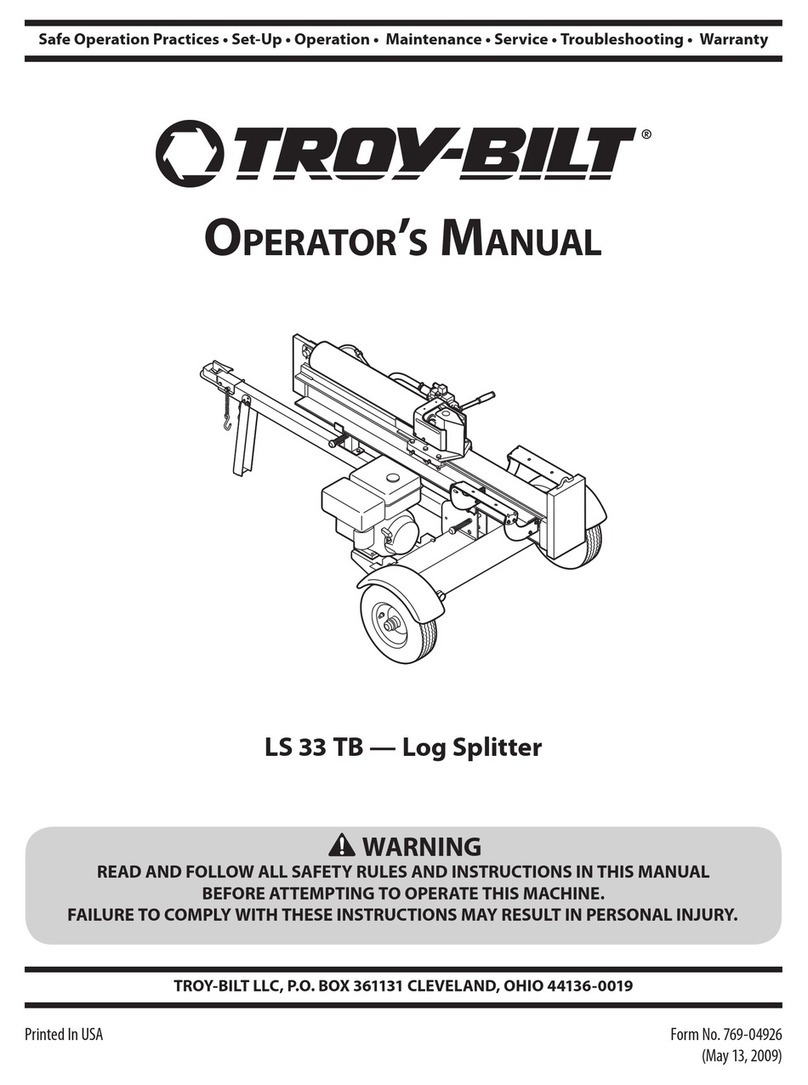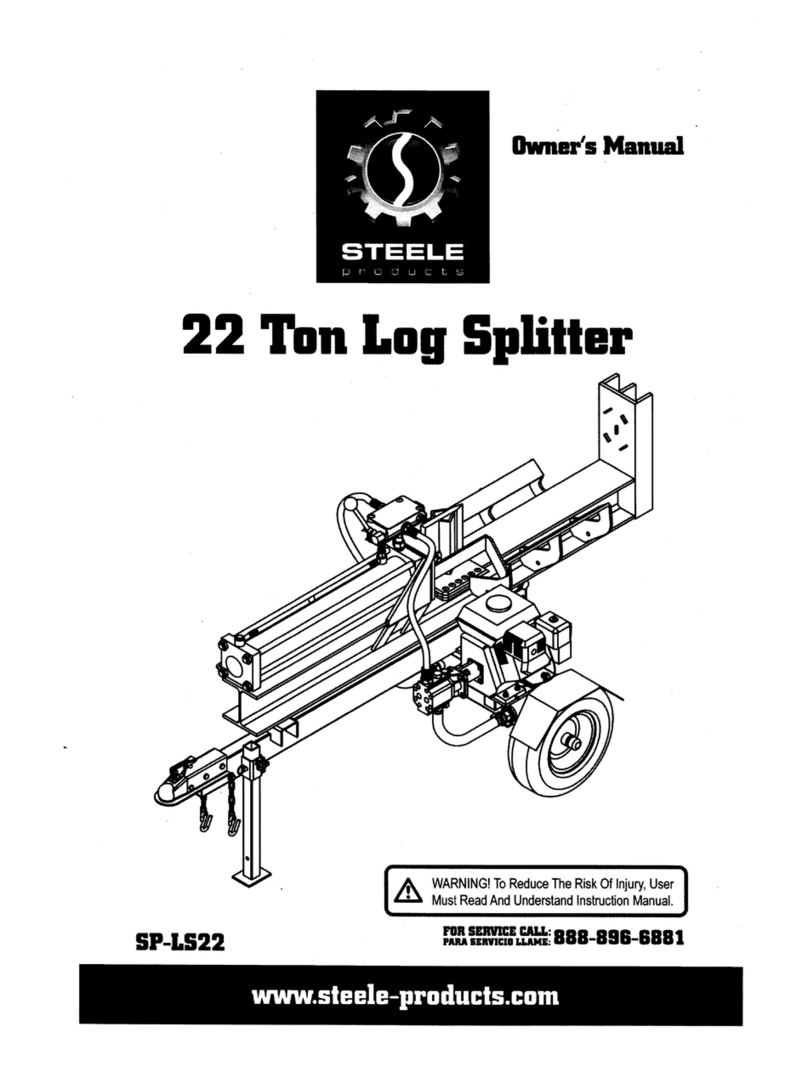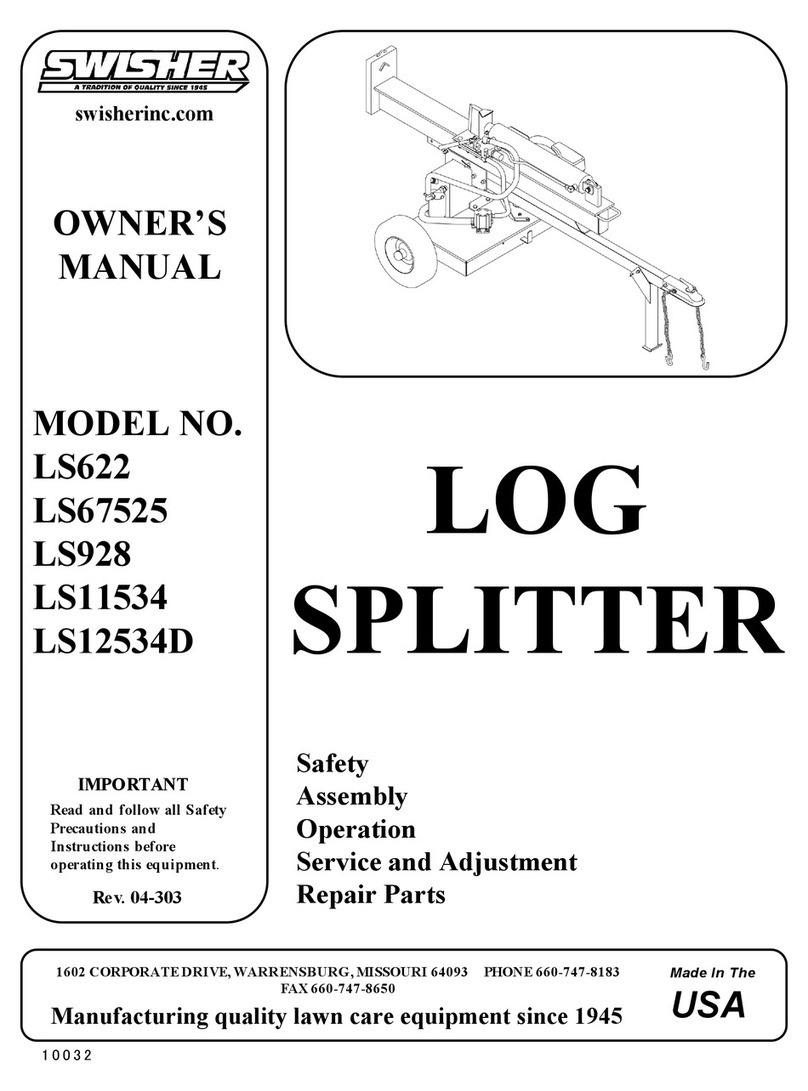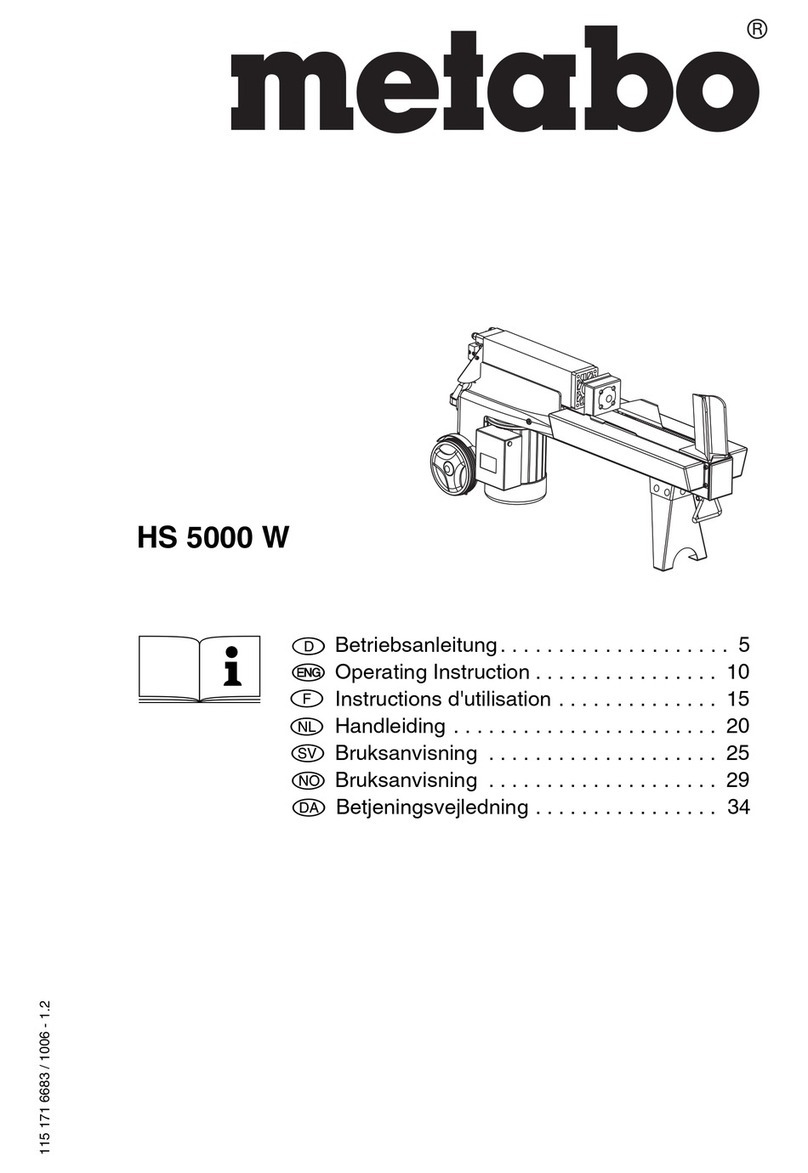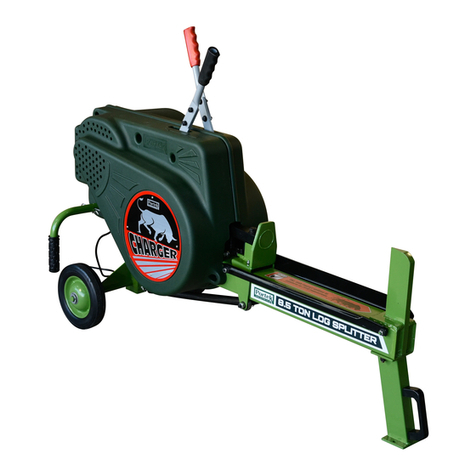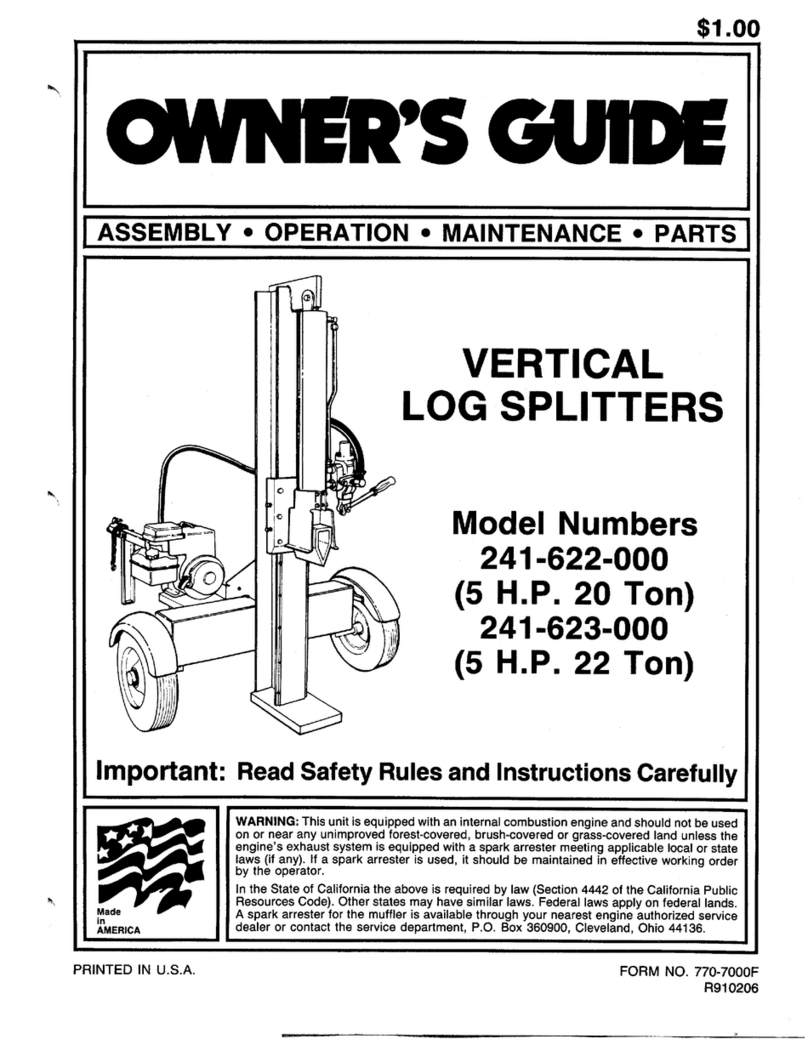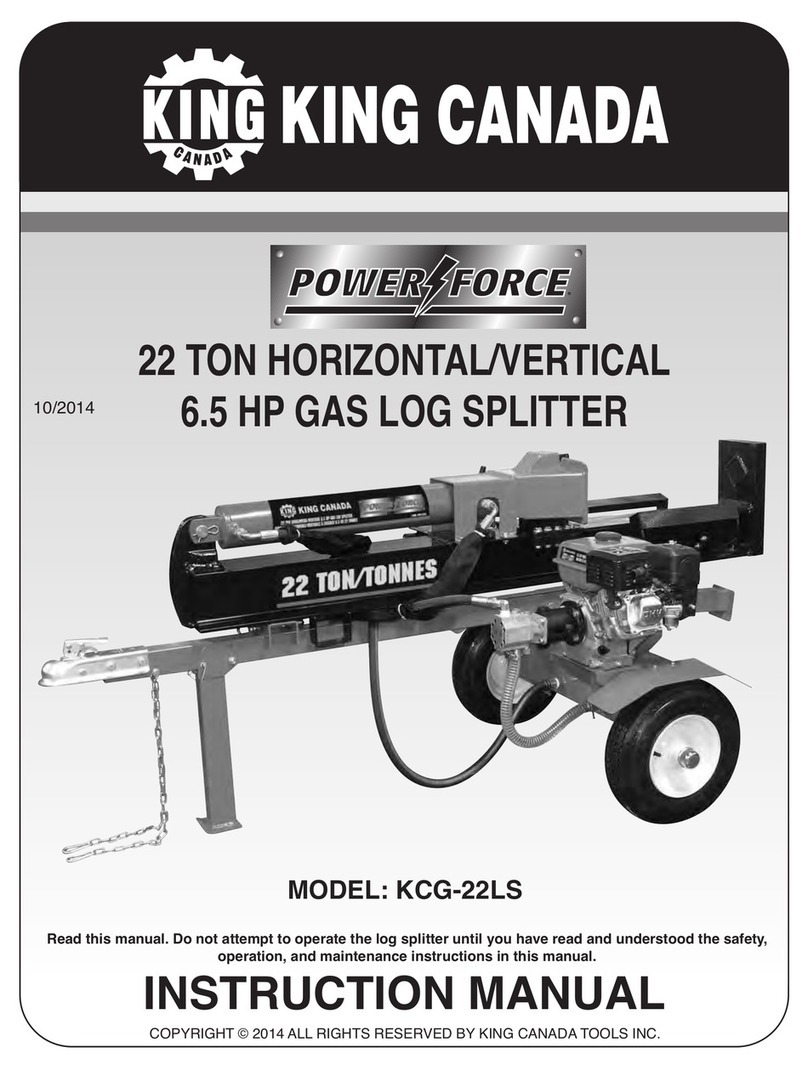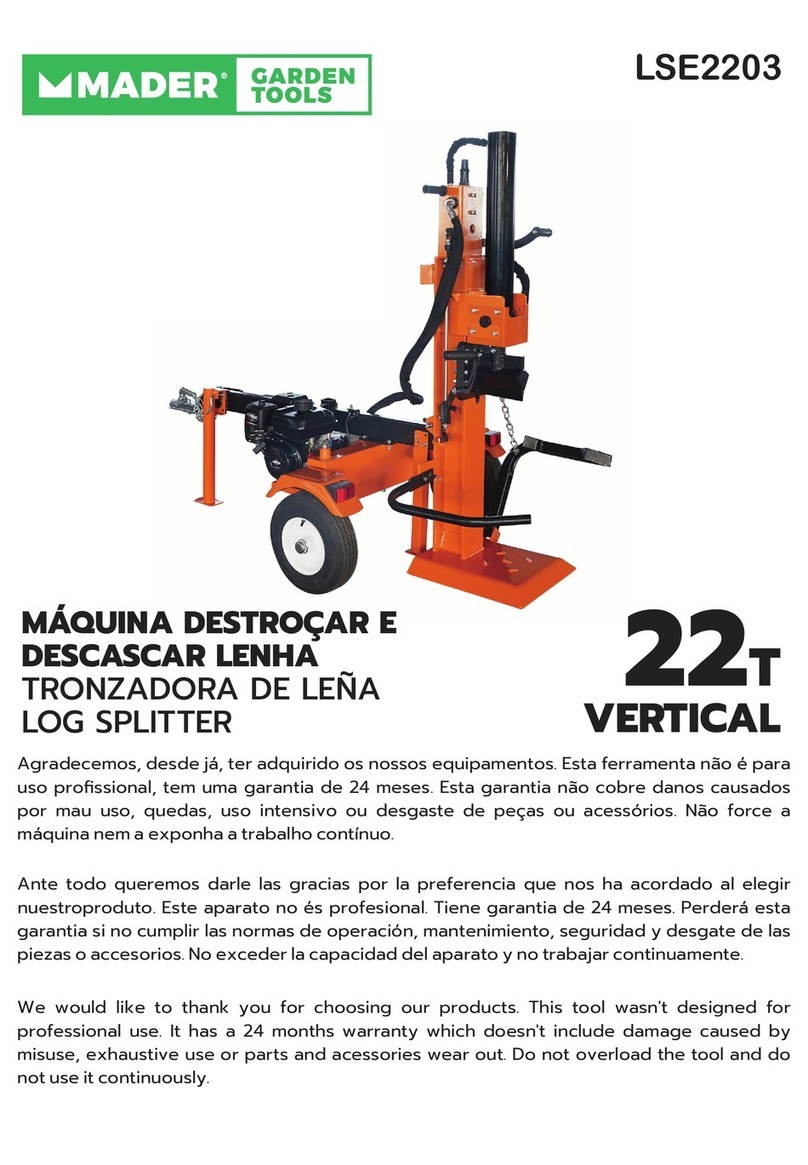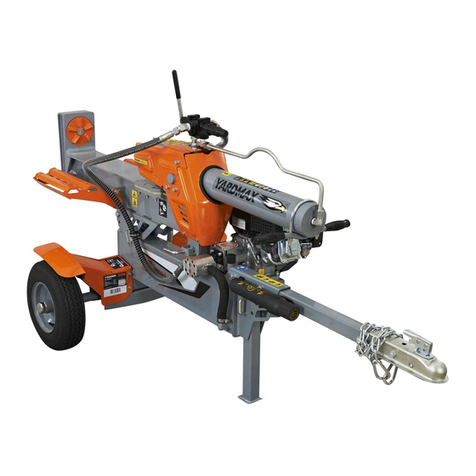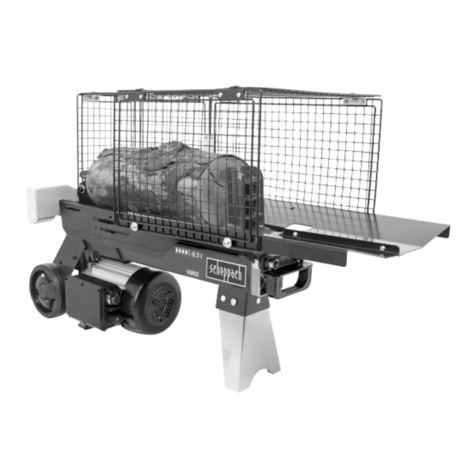Feider Machines FFBE5TS-UK User manual

GB
1
ORIGINAL INSTRUCTIONS
ELECTRIC LOGSPLITTER
FFBE5TS-UK
READ THIS INSTRUCTIONS MANUAL BEFORE USING THE TOOL
FEIDER 32, rue Aristide Bergès - ZI 31270 Cugnaux – France Made in PRC 2019

GB
2
Danger! Keep clear of moving parts!
To be operated by one person only!
The log splitter must be used horizontally, can’t be used vertically.
SAFETY WARNINGS
SAFETY WARNINGS & INSTRUCTIONS
SYMBOL AFFIXED TO
THE MACHINE
⚫UNDERSTAND YOUR LOG SPLITTER
Read and understand the owner’s manual and labels affixed to
the log splitter. Learn its application and limitations as well as the
specific potential hazards peculiar to it.
⚫DRUGS, ALCOHOL AND MEDICATION
Do not operate the log splitter while under the influence of drugs,
alcohol, or any medication that could affect your ability to use it
properly.
⚫AVOID DANGEROUS CONDITIONS
Put the log splitter on a 60 - 75cm high, stable, flat, and level
work bench where there is plenty of room for handling, and help
the operator stay alert. Bolt the log splitter to the work surface if it
tends to slip, walk, or slide.
Keep your work area clean and well lighted. Cluttered areas
invite injuries.
Do not use the log splitter in wet or damp areas or expose it to
rain.
Do not use it in areas where fumes from paint, solvents or
flammable liquids pose a potential hazard.

GB
3
⚫INSPECT YOUR LOG SPLITTER
Check your log splitter before turning it on. Keep guards in place
and in working order. Form -a habit of checking to see that keys
and adjusting wrenches are removed from tool area before
turning it on. Replace damaged, missing or failed parts before
using it.
⚫DRESS PROPERLY
Do not wear loose clothing, gloves, neckties or jewelry (rings,
wrist watches). They can be caught in moving parts.
Protective electrically non-conductive gloves and non-skid
footwear are recommended when working. Wear protective hair
covering to contain long hair, preventing it from get caught in
machinery.
⚫PROTECT YOUR EYES AND FACE
Any log splitter may throw foreign objects into the eyes. This can
cause permanent eye damage. Always wear safety goggles.
Everyday eyeglasses have only impact resistant lenses. They
are not safety glasses.
Do not put the log splitter on the ground for operations. This is
awkward operating position that the operator has to bring his face
close to the machine, and thus risks being struck by wood chips
or debris.
⚫EXTENSION CORDS
Improper use of extension cords may cause inefficient operation
of the log splitter which can result in overheating. Be sure the
extension cord is no longer than 10m and its section is no less
than 2.5mm2 to allow sufficient current flow to the motor.
Avoid use of free and inadequately insulated connections.
Connections must be made with protected material suitable for
outdoor use.
⚫AVOID ELECTRICAL SHOCK
Check that the electric circuit is adequately protected and that it
corresponds with the power, voltage and frequency of the motor.
Check that there is a ground connection, and a regulation
differential switch upstream.
Ground the log splitter. Prevent body contact with grounded
surfaces: pipes, radiators, ranges, and refrigerator enclosures.
Never open the pushbutton box on the motor. Should this be
necessary, please contact a qualified electrician.
Mark sure your fingers do not touch the plug’s metal prongs when
plugging or unplugging the log splitter.

GB
4
⚫KEEP VISITORS AND CHILDREN AWAY
The log splitter must be always operated by one person only.
Other people should keep a safe distance from the work area,
especially when the log splitter is under operations. Never use
another people to help you with freeing jammed log.
⚫INSPECT YOUR LOG
Make sure there are no nails or foreign objects in logs to be split.
The ends of the logs must be cut square. Branches must be cut
of flush with the trunk.
⚫DON’T OVERREACH
Floor must not be slippery.
Keep proper footing and balance at all times.
Never stand on log splitter. Serious injury could occur if the tool is
tipped or if the cutting tools is unintentionally contacted. Do not
store anything above or near the log splitter where anyone might
stand on the tool to reach them.
⚫AVOID INJURY FROM UNEXPECTED ACCIDENT
Always pay full attention to the movement of the log pusher.
Do not attempt to load the log on until the log pusher has
stopped.
Keep hands out of the way of all moving parts.
⚫PROTECT YOUR HANDS
Keep you hands away from splits and cracks which open in the
log; They may close suddenly and crush or amputate your hands.
Do not remove jammed logs with you hands.
⚫DON’T FORCE TOOL
It will do a better and safer job at its design rate. Never try to split
logs larger than those indicated in the specifications table. This
could be dangerous and may damage the machine.
Don’t use log splitter for a purpose for which it was not intended.
⚫NEVER LEAVE TOOL RUNNING UNATTENDED
Don’t leave tool until it has come to a complete stop.
⚫DISCONNECT POWER
Unplug when not in use, before making adjustments, changing
parts, cleaning, or working on the log splitter; Consult technical
manual before servicing.
⚫PROTECT THE ENVIRONMENT
Take used oil to an authorized collection point or follow the
stipulations in the country where the log splitter is used.
Do not discharge into drains, soil or water.
⚫MAINTAIN YOUR LOG SPLITTER WITH CARE

GB
5
Keep the log splitter clean for best and safest performance.
⚫MAKE THE WORKSHOP CHILDPROOF
Lock the shop. Disconnect master switches. Store the log splitter
away from children and others not qualified to use it.
Symbols
WARNING! Electricity - Risk of electric shock.
Warning: Floor-level obstacle
Warning: Risk of slipping
No smoking in the working area
The log splitter must be always operated by one
person only. Never use another people to help you with freeing
jammed log.
1. The log splitter must always be used by one operator only.
2. Nobody must be allowed to use the log splitter unless they have read the
instruction manual and have been instructed in the regulations to follow for
correct and safe use.
Operators must receive necessary training and instructions.

GB
6
3. The machine must be used by adults only. Use of the log splitter by
apprentices of not less than 16 years of age must be supervised by an adult
authorized to use the machine.
4. Never wear loose, unbuttoned clothing which may become trapped in moving
parts.
5. Check that the logs to be split are free from nails or wire, which may fly up or
damage the machine, the ends of the logs must be cut square, branches must
be cut off flush with the trunk.
6. Never try to split logs larger than those indicated in the technical specifications.
This could be dangerous and may damage the machine.
7. Break wood in the direction of the grain, do not place wood across the log
splitter and leave it in that position for splitting; it may be dangerous and may
seriously damage the machine.
8. Never attempt to cut two logs at once, one may fly up and hit you.
9. If the log moves away from the blade, retract the blade and turn the log
through 900.
10.Do not attempt to load the log in the log splitter while the blade is in motion,
you could get trapped and injured.
11.Keep your hands well away from any splits and cracks which open in the log;
these may close suddenly and crush or amputate your fingers.
12.Never force the log splitter for more than 5 seconds keeping the cylinder under
pressure in the attempt to split excessively hard wood. After this time interval,
the oil under pressure is overheated and the machine could be damaged. It is
thus better to stop and rotate the log by 900 to see whether it can be split in a
different position. In any case, if you are not able to split the log, this means
that its hardness exceeds the capacity of the machine and thus that log should
be discarded so as not to damage the lop splitter.
13.Do not force the blade by pushing the log on the upper part, as this can cause
the blade to break or damage the body of the machine. Always set the log on
the guides.
14.Never leave the machine unattended while it is running. If you leave the
machine, even for a short time, remove the power supply or any possible
cause of accidental start-up.
15.The log splitter must never be used by an operator who is under the influence
of alcohol, drugs, medicines, or who is tired. A clear mind is essential for
safety.
16.Never request the assistance of another person to help you remove a jammed
log.
17.Do not use machines with electric motor if natural gas, petrol fumes or other
inflammable vapors are present.
18.Check that the electric circuit is adequately protected and that it corresponds
with the power, voltage and frequency of the motor, check that there is a
ground connection, and a regulation differential switch upstream.
Check on the functioning of the machine.

GB
7
19.Never open the switch box on the motor. Should this be necessary, contact a
qualified electrician.
20.Make sure that the machine and the cable never come in contact with water.
21.Treat the power cable with care, do not attempt to move the machine by
pulling the cable, do not yank the cable to unplug it; keep the cable away from
excessive heat, oil and sharp objects.
22.Never leave the machine unattended with the power supply “on”, also
disconnect the power cable when not in use, when carrying out maintenance
work, when changing attachment or moving the machine.
23.Before starting work, hydraulic pipes and hoses shall be inspected and the
stopping devices shall be tested.
24.Keep the working area free from obstructions, e.g. logs, split wood etc.
25.Stop the machine before cleaning or making adjustments.
26.The hazards may arise from particular characteristics of wood when being split
(e.g. knots, logs of irregular shape etc.)
27.Operator must receive necessary training and instruction from a qualified
person before handling the tool.
28.Use the tool only for the intended use. Misuse (such using material other than
log) can damage the tool and cause accidents and injuries.
29.The splitting operation of the machine is designed to be activated by one
person. While there is the possibility that additional operators could be working
with the machine (e.g. for loading and unloading), only one operator should
activate splitting operations.
30.The machine shall not be used by children.
31.Wear suitable personal protective equipment (PPE), including safety footwear;
close fitting clothing and suitable work gloves, eye protection and hearing
protection.
32.Before starting work, hydraulic pipes and hoses shall be inspected and the
stopping devices shall be tested.
33.Tests of the machine's safety devices before use the tool. If safety devices do
not work properly, do no use the tool and bring it to a qualified technician for
inspection and reparation.
34.The working area shall be free from obstructions; before installation and
operation, clear the working area. Keep the working area free from
obstructions, e.g. logs, split wood, etc.
35.Do not leave the machine unattended when running;
36.Do not reach into the splitting zone;
Electrical Safety
WARNING! Always check that the power supply corresponds to the voltage on
the rating plate.
WARNING! Connect the main leads to a standard 230V±10% (50Hz±1Hz)
electrical supply which has protection devices of under-voltage,

GB
8
over-voltage, over-current as well as a residual current device (RCD) which
maximum residual current rated at 30mA.
Replacing cables or plugs
If the supply cord is damaged, it must be replaced by the manufacturer, its service
agent or similarly qualified persons in order to avoid a hazard.
Immediately throw away old cables or plugs when they have been replaced by
new ones. It is dangerous to insert the plug of a loose cable in the wall outlet.
Using extension cables
1. As a supply for this machine always use an unloaded line and/or extension
with conductor of at least 2.5mm2 and protected with a 20A fuse. Be sure that
this extension cable is not longer than 10 meters. Excessively long cables or
inadequate section can cause voltage drops that prevent motor from
developing its full power.
2. Only connect your machine and/or extension cable to earthed electricity
mains.
Grounding
In the event of an electrical short circuit, grounding reduces the risk of electric
shock. Use switch socket with grounding please.
INTENDED USE
This log splitter is only intended to be used to split logs! Serious injury may occur
if this log splitter is used for any other purpose.
TECHNICAL SPECIFICATIONS
Model
FFBE5TS-UK
Voltage:
230V~ 50Hz
Power consumption
1500W S3 50% (5min on/5min off)
No load Speed:
2,800min-1
Classification
Class I
Protection degree
IP 54
Max. splitting force (tons)
5 t
Diameter
30-250mm
Length
520mm
Max. Hydraulic oil capacity
3.3L
Max. hydraulic pressure
20MPa
Mass
65Kg
Sound pressure level, LpA
78 dB(A) k=3dB(A)
Sound power level, LWA
89 dB(A) k=3dB(A)

GB
9
Vibration
≤2,5m/ s2
Guarantee noise level
91 dB(A)
UNPACKING
WARNING! To prevent accidental starting that could cause possible serious
personal injury, assemble all parts to your log splitter before connecting it to power
supply. Log splitter should never be connected to power supply when you are
assembling parts, making adjustment.
Carefully remove all parts from the carton and place the log splitter on a level work
surface of the height not less than 60cm. Separate and check against the list of
loose parts.
WARNING! If any parts are missing, do not operate this machine until the missing
parts are replaced. Failure to do so could result in serious personal injury.
•Do not discard the packing materials until you have carefully inspected the log
splitter, identified all parts, and satisfactorily operated your new log splitter.
Check all loose parts from the box with the list below. Assemble according to the
instruction on the following pages.
1 horizontal leg 1pcs
2 front stand 2pcs
3 back stand 2pcs
4 horizontal shaft 2pcs
5 wheel 2pcs
6 wheel shaft 2pcs
7 wheel cover 2pcs
8 circlip 8pcs
9 Bolt M8*50 4pcs
Bolt M8*45 6pcs
10 Nut M8 4pcs
11 Flat washer 12pcs
12 Spring washer 4pcs

GB
10
FEATURES
1. Before attempting to use, familiarize yourself with all the operating
features and safety requirements of your log splitter.
1. Blade
2. Oil tank
3. hydraulic
control lever
4. Rolling wheel
5. push button switch
6. Log pusher
7. Safety guard for
hydraulic control lever
8. horizontal leg
9. horizontal shaft
10.front stand
11. wheel shaft
12. motor cover
13.back stand
2. Size of the logs to be split
The figure 1 shows the maximum log sizes that can be split.
The diameter of the log is indicative: a small log can be difficult to split if it has
knots or a particularly tough fiber. On the other hand, if the wood has regular
fibers it is not difficult to split logs with diameter greater than the maximum shown
in fig. 1.
It is important not to insist when the log does not split on the first attempt,
as the pump may be damaged by the overheating of the oil when the
machine is made to work under the maximum stress in the attempt to split
excessively hard wood.

GB
11
3. Recommended oils
We recommend use of the following oils for the hydraulic cylinder.
SHELL TELLUS T22
ARAL VITAM GF22
SP ENERGOL HCP22
MOBILE DTE 11 OR equivalent
DO NOT USE OTHER GRADE OILS
4. Application conditions
This log splitter is a home use model. It is designed for operating under ambient
temperature between +50C and 400C and use at altitudes no more than 1000mm.
The surrounding humidity should less than 50% at 400C. It can be stored or
transported under ambient temperatures between -250C and 550C.
ASSEMBLY
Warning! For your own safety, do not connect the log splitter to the power
source until the machine is completely assembled and you read and
understand the entire instruction manual.
Warning! For your own safety, never forget to bolt the support legs to the
log splitter, place the log splitter on flat and level ground.
Warning! Never use the log splitter if it is not in perfect order or if it needs
servicing. Before starting work, check correct functioning of all the safety
devices (ZHB, push button).
a) Connect front stand (10a) to connection pipe (a) and front stand (10b) to
connection pipe (b) by bolts and nuts (fig.2).
Fig.1

GB
12
fig.2
b) Connect horizontal shaft (9a) to front stand(10a&10b) with screws, then
assemble horizontal leg(8) and fix it to front stand(10a&10b) by bolts (fig.3).
fig.3
c) Connect back stand (13c) to connection pipe (c) and connect back stand (13d)
to connection pipe (d) by bolts and nuts (fig.4).

GB
13
fig.4
d) Connect horizontal shaft (9b) to back stand (13c&13d) with bolts, assemble
the wheel shaft (11) and wheels with four spring washers, the last fit wheel
covers (fig.5).
fig.5
Remove the accessories as shown in the figure from the carton and check the number of
accessories, and then install according to the following steps:

GB
14
1. Using the Allen wrench to make the two M8×16 screws through the two washer8 and the
mounting hole for left side support plate, then tighten the screw holes corresponding to the bent
legs( fig. 1)
Fig.1
2、Push the three M8×16 screws through the three washer8 and the mounting hole, then tighten the
screw holes corresponding to the bent legs. Push the four M8×16 bolts through the mounting hole of
the connecting plate and the support plate, then tighten with four M8 nuts. (Fig.2)
Fig.2
3、Connect the back cover, protection guard and support plate with M8×16 bolt and M8 nut. (Fig. 3)
Fig. 3

GB
15
4、Install the stock support plate. Push the two M8×16 screws through mounting hole of the support
plate and the stock support plate, tighten with two M8 nuts. Then push two M8×16 screws through
the two mounting hole of the stock support plate, push two M8×50 bolts through the mounting hole
of the left and right bent legs and mounting hole of the stock support plate on the other side, tighten
with four M8 nuts. (Fig. 4)
Fig. 4
5、After the third step, an entire machine has been assembled
OPERATION
Warning!
Before operating the log splitter, the Bleed Screw (15) Fig. 6, should be
loosened by some rotations until air can go in and out of the oil tank
smoothly.
Air flow through the Bleed Screw hole should be detectable while the log
splitter is under operations.
Before moving the log splitter, make sure the Bleed Screw is tightened to
avoid oil leaking from this point.
Failed to loosen the bleed screw will keep the sealed air in hydraulic system being
compressed after being decompressed, such continuous air compression and
decompression will blow out the seals of the hydraulic system and cause
permanent damage to the log splitter.

GB
16
Fig.6
DO NOT ADJUST THE MAX PRESSURE
LIMITING SCREW (16) IN FIG. 7!
Max pressure was set before the log splitter ex work and the max pressure
limiting screw is tightened to ensure the log splitter works under pressure
no more than 6 tons. The setting was done by qualified mechanic with
professional instruments.
Unauthorized resetting will cause the hydraulic pump fail to output enough
splitting pressure or RESULT IN SERIOUS INJURY AS WELL AS DAMAGE
TO THE MACHINE.
Fig. 7
Make sure that the screws are tightened up properly before operation the
log splitter!
This log splitter is equipped with control system that requires to be operated by
both hands of the user – left hand controls the hydraulic control lever (3) while
right hand controls the push button switch (5) as shown in Fig. 8. The log splitter

GB
17
will freeze upon absence of either hand. Only after both hands release the
controls, the log pusher starts to return backward to the starting position.
Never force the log splitter for more than 5 seconds by keeping pressure on
it to split excessively hard wood.
Fig .8
After this time interval, the oil under pressure will be overheated and the machine
could be damaged. For such extremely hard log, rotate it by 900 to see whether it
can be split in a different direction. In any case, if you are not able to split the log,
this means that its hardness exceeds the capacity of the machine and thus that
log should be discarded to protect the log splitter.
NOTE: During operation, the metal part connected to the motor remains cold or in
any case reaches a temperature only slightly higher than the ambient temperature.
After several hours of use with particularly difficult wood, the pump may become
very hot. This is not a dangerous situation for the machine, which returns to full
functioning capacity after being cooled. On the other hand, it is very important not
to cause overheating of the oil, and thus the pump, by forcing the machine in an
attempt to split logs that exceed the capacity of the machine.
Always set logs firmly on the log retaining plates and work table. Make sure
logs will not twist, rock or slip while being split. Do not force the blade by
splitting the log on the upper part. This will break the blade or damage the
machine. (Fig.9)

GB
18
Fig. 9
Break log in the direction of its grown grain. Do not place log across the log splitter
for splitting. This may be dangerous and may seriously damage the machine.
Do not attempt to split 2 pieces of logs at the same time. One of them may fly up
and hit you.
Freeing a jammed log (fig.10)
1. Release both controls.
2. After the log pusher moves back and completely stops at its starting position,
insert a wedge wood under the jammed log.
3. Start the log splitter to push the wedge wood to go completely under the
jammed one.
4. Repeat above procedure with sharper slope wedge woods until the log is
completely free.
Fig.10
Do not try to knock the jammed log off. Knocking will damaged the machine
or may launch the log and cause accident (fig.11).

GB
19
Fig.11
MAINTENANCE
Replacing hydraulic oil (fig.12)
Replace the hydraulic oil in the log splitter after every 150 hours of use. Take
following steps to replace it.
1. Make sure all moving parts stops and the log splitter is unplugged.
2. Unscrew oil drain bolt (14 ) (fig.6) with dipstick to remove it.
3. Turn the log splitter on the support leg side over a 3.3 liter capacity container
to drain the hydraulic oil off.
4. Turn the log splitter on the motor side.
5. Refill fresh hydraulic oil at the volume as per the hydraulic oil capacity of a
particular model indicated in the specifications table.
6. Clean the surface of Dipstick on the oil drain bolt and put it back into the oil
tank while keep the log splitter vertically.
7. Make sure the level of the refilled oil is just between 2 grooves around the
dipstick.
8. Clean the oil drain bolt before thread them back. Make sure they are tightened
to avoid leakage before placing the log splitter horizontally.

GB
20
fig.12
Periodically check oil level to ensure it is between 2 grooves around the
dipstick. Upon lower oil level, oil refilling is required.
Warning: Never mix oil with general waste!
Used oil must be disposed of according to current regulations in the
country where the machine is used.
Sharpening the wedge
After using the log splitter for some time, sharpen the wedge of the log splitter
using a fine-toothed file and smooth any burrs or crushed area along the cutting
edge
STORAGE
When you have finish working with your log splitter:
1. Disconnect the log splitter from the mains supply.
2. Tighten the oil yank cover / air bleeder,
3. Clean the unit down using a dry cloth.
4. Store in a dry and well-ventilated area.
TROUBLESHOOTING
PROBLEM
PROBABLE CAUSE
REMEDY SUGGESTED
Motor stops
starting
Overload protection device
disengaged to protect the log
splitter from being damaged
Let motor cool down, and
push the button of the
overload protection device to
re-start the motor
Fails to split
logs
Log is improperly positioned
Refer to “Log splitter
operation” section for perfect
log loading
The sizes or hardness of the
log exceeds the capacity of the
machine
Reduce the log size before
splitting it on the log splitter
Wedge cutting edge is blunt
Refer to “Sharpening wedge
“section to sharpen the
cutting edge.
Oil leaks
Locate leak(s) and contact
the dealer
Unauthorized adjustment was
made on Max. Pressure
Limiting Screw. Lower max
pressure rating was set.
Contact the dealer
Table of contents
Other Feider Machines Log Splitter manuals
